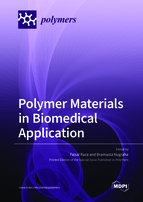Polymer Materials in Biomedical Application
A special issue of Polymers (ISSN 2073-4360). This special issue belongs to the section "Biomacromolecules, Biobased and Biodegradable Polymers".
Deadline for manuscript submissions: closed (30 November 2021) | Viewed by 77472
Special Issue Editors
Interests: 3D cell culture; biomaterials; tissue engineering; hydrogel; organoids; drug discovery; bioimaging; cardiorenal; metabolic disease; stem cell biology
Interests: biomimetic nanomedicine; polymeric nanoparticle; drug delivery; cancer; tumor microenvironment; biomaterials; cancer nanomedicine
Special Issues, Collections and Topics in MDPI journals
Special Issue Information
Dear Colleagues,
In recent days, the development of polymeric materials for biomedical applications has advanced significantly. Polymeric materials are favored in the development of therapeutic devices, including temporary implants and three-dimensional scaffolds for tissue engineering and in vitro disease modelling.
Further advancements have also occurred in the utilization of polymeric materials for pharmacological applications such as delivery vehicles for drug release.
We would like to invite you to contribute to this Special Issue. Research topics of interest include, but are not limited to, recent advances related to 3D cell culture, biomaterials, tissue engineering, disease modelling, hydrogel, organoids, drug discovery, bioimaging, cardio-renal, metabolic disease, and stem cell biology.
Authors are welcome to submit their latest research efforts in the form of original regular articles, communications, or reviews on these topics.
Dr. Bramasta Nugraha
Guest Editor
Manuscript Submission Information
Manuscripts should be submitted online at www.mdpi.com by registering and logging in to this website. Once you are registered, click here to go to the submission form. Manuscripts can be submitted until the deadline. All submissions that pass pre-check are peer-reviewed. Accepted papers will be published continuously in the journal (as soon as accepted) and will be listed together on the special issue website. Research articles, review articles as well as short communications are invited. For planned papers, a title and short abstract (about 100 words) can be sent to the Editorial Office for announcement on this website.
Submitted manuscripts should not have been published previously, nor be under consideration for publication elsewhere (except conference proceedings papers). All manuscripts are thoroughly refereed through a single-blind peer-review process. A guide for authors and other relevant information for submission of manuscripts is available on the Instructions for Authors page. Polymers is an international peer-reviewed open access semimonthly journal published by MDPI.
Please visit the Instructions for Authors page before submitting a manuscript. The Article Processing Charge (APC) for publication in this open access journal is 2700 CHF (Swiss Francs). Submitted papers should be well formatted and use good English. Authors may use MDPI's English editing service prior to publication or during author revisions.
Keywords
- 3D cell culture
- biomaterials
- tissue engineering
- hydrogel
- organoids
- drug discovery
- bioimaging
- cardiorenal
- metabolic disease
- stem cell biology








